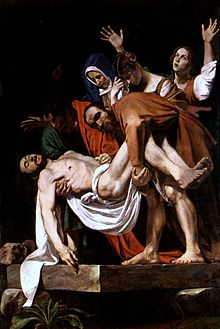- Mary of Clopas
-
"The other Mary" redirects here. For the novel, see The Other Mary (novel).
Mary of Clopas or Cleopas (Ancient Greek: Μαρία ἡ τοῦ Κλωπᾶ, Maria he tou Klopa) the wife of Clopas was one of various Marys named in the New Testament.
Mary of Clopas is explicitly mentioned only in John 19:25, where she is among the women present at the Crucifixion of Jesus:
Now there stood by the cross of Jesus His mother, and His mother’s sister, Mary [the wife] of Clopas, and Mary Magdalene.
The expression Mary of Clopas in the Greek text is ambiguous as to whether Mary was the daughter or wife of Clopas, but exegesis has commonly favoured the reading "wife of Clopas" (as reflected in above translation). Hegesippus thought that Clopas as the brother of Saint Joseph. Some have regarded Mary as the daughter of Clopas, who was in turn one of the husbands of Saint Anne.[1]
In a manner very similar to the Gospel of John, the apocryphal Gospel of Philip also seems to list Mary of Clopas among Jesus' female entourage:
There were three who always walked with the Lord: Mary, his mother, and her sister, and Magdalene, the one who was called his companion. His sister and his mother and his companion were each a Mary.[note 1]
Adding to the confusion, the Gospel of Philip seems to refer to her as Jesus' mother's sister ("her sister") and Jesus' own sister ("his sister").
According to some interpretations, the same Mary was also among the women that on Easter morning went to the tomb to anoint Jesus' body with spices. Matthew 28:1 calls her "the other Mary" to distinguish her from Mary Magdalene, while Mark 16:1 uses the name "Mary of James", most probably derived from James the Less. The Latin version of that name, Maria Iacobi, is often used in tradition. S. S. Smalley says that it is "very probable" that Mary of Clopas is Mary the mother of James.[2]
In John 19:25 Mary of Clopas appears immediately after the expression "His mother’s sister". Therefore, Mary is often seen as the sister of Jesus's mother, despite the awkwardness of having two sisters bearing the same name. However, other interpretations distinguish between two different persons, one being "His mother's sister" and the other being "Mary of Clopas". Still, other interpretations make Mary of Clopas not the sister but the cousin of Jesus' mother, as Hebrew or Aramaic had no specific word for cousin, or her sister-in-law, as Clopas was considered the brother of Joseph.
In chapter 24 of the gospel of Luke, there is an account of Jesus appearing to two people walking on the road to Emmaus after His resurrection. Luke 24:18 identifies one of the persons as "Cleopas" who is believed to be Mary's husband. Some biblical scholars speculate the other person with Cleopas on the road was his wife, Mary.
An early tradition within the Roman Catholic Church, first visible in the writings of Papias,[note 2] identify her sons James and Joses/Joseph referred to in scripture as the "brothers of Jesus" as his biological cousins, Mary of Clopas being the sister (or sister-in-law, or even cousin) of Mary the Mother of Jesus. Other traditions outside the Church make her the mother of the "brethren of the Lord".
James Tabor suggests that she is, in fact, Mary, the mother of Jesus and that Clopas was her second husband.[3]
In medieval legend the three Marys (Mary Magdalene, Mary Salome, and Mary of Clopas) were adrift in a boat that miraculously arrived off the coast of Provence, now called Saintes-Maries-de-la-Mer. In that legend Mary of Clopas is the mistress of her Egyptian servant Sarah, venerated by Gypsies.
In the Roman Martyrology she is remembered with Saint Salome on April 24. In the Orthodox Church her feast day is commemorated on May 23.[4]
See also
Notes
- ^ The Old and New Testament and Gnostic contexts and the text are discussed by Robert M. Grant, "The Mystery of Marriage in the Gospel of Philip" Vigiliae Christianae 15.3 (September 1961:129-140).
- ^ See Fragment X at Fragments of Papias.
References
- ^
 "St. Anne". Catholic Encyclopedia. New York: Robert Appleton Company. 1913.
"St. Anne". Catholic Encyclopedia. New York: Robert Appleton Company. 1913. - ^ S. S. Smalley, "Mary," New Bible Dictionary, p. 793.
- ^ Tabor, James (2006). The Jesus Dynasty. Simon and Schuster. pp. 90-91.
- ^ (Greek) Ἡ Ἁγία Μαρία ἡ Μυροφόρος τοῦ Κλωπᾶ. 23 Μαΐου. ΜΕΓΑΣ ΣΥΝΑΞΑΡΙΣΤΗΣ.
Categories:- 1st-century Christian female saints
- Eastern Orthodox saints
- Followers of Jesus
- New Testament people
- Saints from the Holy Land
- Gospel of John
Wikimedia Foundation. 2010.

